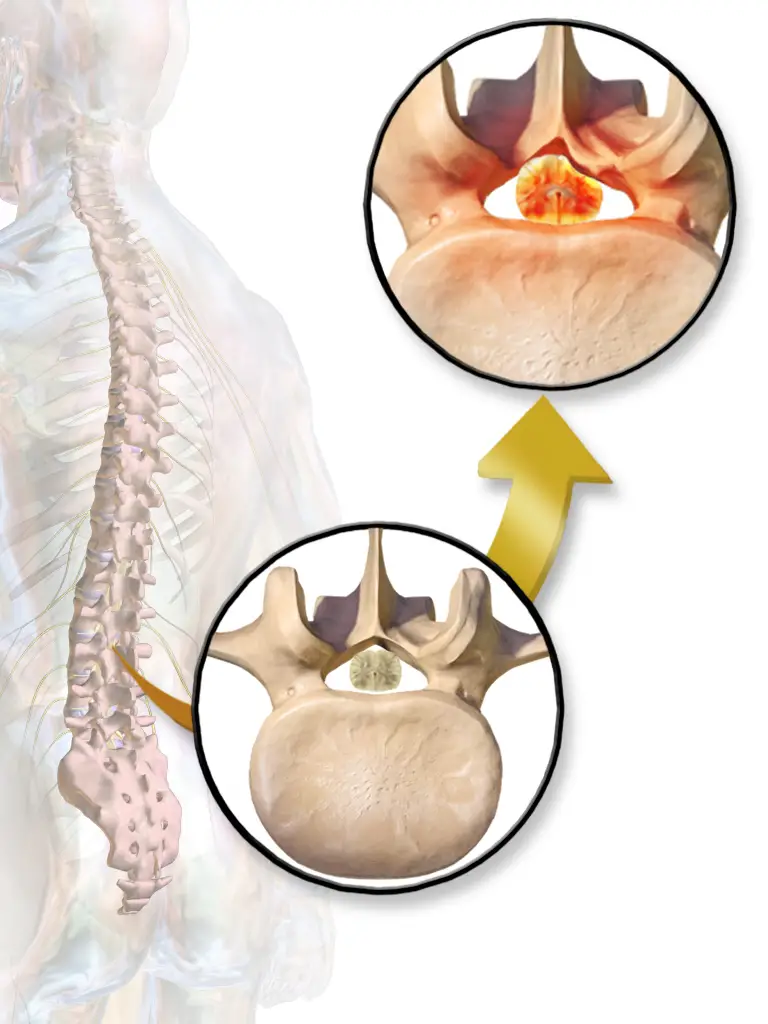Contents
What is Spinal Stenosis?
The spinal canal is the space through which your spinal cord and spinal nerves pass. Spinal stenosis is a narrowing of this space. The condition can be caused by the aging process and is more common in people over age 50. It can also be caused by conditions such as arthritis or tumors.
Spinal stenosis can put pressure on your spinal cord or nerves. This pressure can cause pain, numbness, or weakness in your legs, back, or neck. In severe cases, it can make it hard to walk or even stand for long periods of time.
There are two types of spinal stenosis:
- Central canal stenosis: This happens when the central part of the spinal canal narrows. This type is more common in older adults.
- Foraminal stenosis: This happens when the openings (foramina) that allow nerves to pass from the spinal column to the rest of your body become narrowed. This type is also called foraminal narrowing.
What Causes Spinal Stenosis?
The bones of your spine are held together by thickened ligaments. In between these bones is the spinal canal. This canal houses and protects the spinal cord. When any of these structures narrows, it’s called spinal stenosis.
Spinal stenosis can be caused by a number of things, including:
- Aging
- Genetics
- Stress fractures
- Spinal cord Paget’s disease (a degenerative condition)
It’s more common in older adults, but younger people can get it, too. This is often due to a birth defect or an injury that leads to a smaller spinal canal.
Symptoms of Spinal Stenosis
Spinal stenosis is a condition in which the spinal canal narrows, putting pressure on the spinal cord and nerves. This pressure can lead to pain, numbness, tingling, and weakness in the legs, back, and buttocks. In severe cases, it can cause loss of bowel or bladder control.
The most common symptom of spinal stenosis is pain that radiates from the lower back into the legs. This pain usually gets worse with activity and gets better when you rest.
Other common symptoms include:
- Foot drop (a condition in which it’s difficult to raise your foot)
- Sciatica (pain that radiates down the leg)
- Numbness or weakness in the legs
- Loss of bowel or bladder control
If you have any of these symptoms, it’s important to see a doctor so they can diagnose and treat the condition. In some cases, treatment may include physical therapy, medication, or surgery.
Solutions for Spinal Stenosis
If you suffer from spinal stenosis, you’re not alone. This degenerative spine condition affects millions of Americans, most of whom are over the age of 50. Spinal stenosis occurs when the vertebrae in your spine begin to compress, which puts pressure on the spinal cord and nerves. This can lead to pain, numbness, tingling, and weakness in the back, legs, and arms.
There are a number of solutions for spinal stenosis, both surgical and non-surgical. In this article, we’ll take a look at some of the typical surgery options as well as some of the less invasive options that may be available to you.
Surgery is often seen as the last resort for treating spinal stenosis, but it may be necessary if conservative treatments such as medications, steroid injections, and stretching haven’t provided relief. There are a number of common surgery options for treating this condition, including laminectomy, laminotomy, and laminoplasty.
Laminectomy involves removing the back portion of the vertebrae to create more space for the compressed nerves. Laminotomy is similar but involves only cutting a small section of bone instead of removing it entirely. Laminoplasty is a newer technique that involves enlarging the spinal canal by opening up a section of vertebrae and then holding it open with metal plates or rods.
While surgery may be necessary for some people with spinal stenosis, there are also a number of non-invasive options that can provide relief.
These include medications, chiropractic care, and physical therapy. Inverted decompression is one novel approach that entails hanging upside down from an inversion table for short periods of time each day. This allows gravity to stretch your spine and ease pressure on the nerves.

How Inversion Therapy Works for Spinal Stenosis
When you have spinal stenosis, the vertebrae in your spine narrow and start to crowd your spinal cord. This puts pressure on the nerves in your spine and can cause pain, weakness, and numbness.
Inversion therapy is a type of treatment that can help relieve the pressure on your nerves by using gravity to decompress your spine.
Inversion therapy works by using an inversion table or inversion chair to help you rotate your body so that you’re upside down or at an inverted angle.
When you’re inverted, the force of gravity pulls your spinal discs away from your vertebrae. This gives the discs a chance to rehydrate and receive nutrients from the surrounding tissue. In addition, inverting takes the pressure off of your nerves by relieving any pinched nerves or herniated discs.
Inversion therapy is a safe and effective way to treat disc-related spinal stenosis. However, it’s important to talk to your doctor before starting any new treatment, especially if you have an underlying medical condition.
Inversion therapy is not appropriate for everyone, so it’s important to make sure it’s right for you before trying it.
Benefits and Risks of Inversion Therapy for Lower Back Pain
Inversion therapy is a type of treatment in which a person’s feet are suspended above their head for a brief period of time. This allows the spine to stretch and relieves pressure on the discs and other structures in the spine. Inversion therapy is often used to treat lower back pain, neck pain, and headaches.
There are several ways to perform inversion therapy, including using an inversion table, gravity boots, or a medical device called a Teeter. Inversion tables are the most common type of inversion therapy device. They allow you to adjust the angle of inversion and typically have safety features to prevent you from inverting too far.
Gravity boots are another type of inversion therapy device that can be used for self-treatment at home. These boots strap onto your legs and allow you to hang upside down from a bar or doorframe.
Teeters are medical devices that are specifically designed for inversion therapy and are often used in physical therapy offices or clinics. Teeter inversion tables allow you to adjust the angle of inversion and have built-in safety features to prevent you from inverting too far.
Inversion therapy is generally considered safe when performed properly; however, there are some risks associated with this type of treatment.
These risks include:
- Dizziness or nausea: When first starting inversion therapy, it is common to feel dizzy or nauseous. These symptoms typically go away after a few minutes as your body adjusts to being upside down.
- High blood pressure: If you have high blood pressure, you should not use inversion therapy without first consulting with your healthcare provider. Inverting can cause a sudden spike in blood pressure, which can be dangerous for people with this condition.
- Glaucoma: If you have glaucoma, you should not use inversion therapy without first consulting with your healthcare provider. Inverting can cause an increase in intraocular pressure, which can worsen glaucoma symptoms.
- Spinal cord injury: If you have a spinal cord injury, you should not use innovation therapy without first consulting with your healthcare provider. Inverting may increase the risk of further injury to the spinal cord.
Frequently Asked Questions
Can inversion help with spinal stenosis?
There is no evidence that inversion therapy helps with spinal stenosis. Some people may find that inverting relieves their pain by taking pressure off of the nerves in their spine, but there is no scientific evidence to support this claim.
Is an inversion table good for spinal compression?
An inversion table may help relieve spinal compression by temporarily taking the pressure off of the discs and vertebrae. However, it is important to consult with a spine specialist before beginning any new treatment, as inversion therapy may not be appropriate for everyone.
What activities should be avoided with spinal stenosis?
Activities that should be avoided with spinal stenosis include any activity that causes pain or discomfort in the back or legs. These activities may include standing for long periods of time, walking long distances, or lifting heavy objects. The activities that should also be avoided with spinal stenosis are the ones that put pressure on the spine, such as lifting heavy objects, bending over, and sitting for long periods of time.
inversion tables, inversion table, inversion therapy, inversion table therapy, back pain, gravitational force, spinal stenosis, medical professional, spinal traction, blood pressure, heart rate, health benefits, back pain relief, drug administration, key points, necessary precaution, spinal disks, following health issues, sciatic nerve painmuscle, spasmsspinal curvature, stenosisdegenerative disc, degenerative joint diseasedid, medical devices, inversion treatment, chiropractors.do inversion tables, pain, negative side effects, upside down, modern medicine, physical therapy, chiropractic, lower back, low back pain, chiropractic adjustments, sciatica, rehabilitation, chronic back pain, the opioid crisis, physical therapy, pain relief, chiropractors, osteoporosis, massage, inversion, pain management, asanas
Conclusion
After reading this article, you should have a better understanding of inversion table therapy and how it might help relieve some of the symptoms associated with spinal stenosis.
While there is no guarantee that this treatment will be effective for everyone, it is definitely worth considering if you are looking for an alternative to more traditional methods of pain relief.
Inversion table therapy is a safe, non-invasive way to decompress the spine and take pressure off of the discs and nerves. If you suffer from spine-related pain, give inversion therapy a try – it just might help you find the relief you’ve been searching for!

Dave Lee is the founder of Spine Institute NY, a huge fan of inversion therapy, a researcher, and an author.

